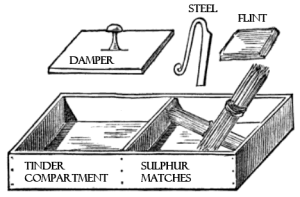Nowadays when we use the word “tinderbox” we are usually speaking metaphorically.
To many of our ancestors this meant something more sophisticated than a simple container of tinder. I suspect some of our ancestors would have had a good chuckle at the performance some outdoorsman make of using a ferro-rod and steel!
During my recent researches I came across a number of tinderboxes of the following pattern:

Essentially the box has two compartments. One compartment contains a flint and steel and a number of sulphur matches. The other compartment contains a pad of charcloth. A wooden damper fits into the second compartment. In some example the tinderbox only holds the charcloth and damper, the other components being kept separately.

When fire was needed, the flint and steel was struck so that sparks landed on the charcloth. Charcloth has a very low ignition temperature so is well suited to use with flint and steel. Once the charcloth is burning it is used to light one of the sulphur matches. The match is used to transfer the flame to you kindling, clay pipe or wherever else you need it. The damper is used to snuff out the burning charcloth until it is needed again. In some examples replacing the tight lid may have been enough to extinguish the flame.

An interesting component of this system were the sulphur matches. If you look at the boxes of some brands of modern matches you may still find the statement that they are “self-igniting” or similar. This is because matches as we know them are a relatively new invention. For centuries the word match meant something like the burning cord of a matchlock or the sulphur matches in a tinderbox.
Sulphur matches were also known as brimstone matches or spunks. They are simply strips of wood with each end dipped in molten sulphur and allowed to dry. Commonly they were made and sold by street vendors. Below is a nice video on making sulphur matches.